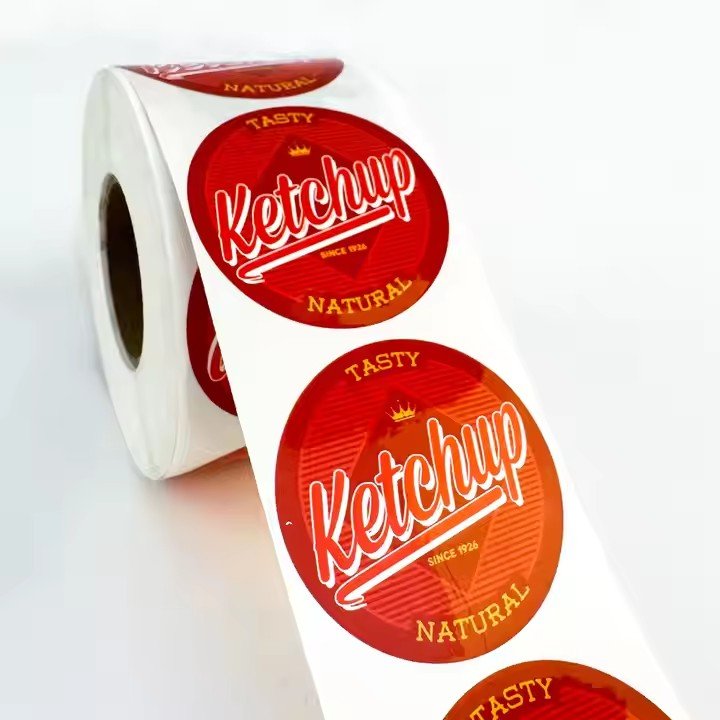I. Compliance First: Define Regulatory Boundaries and Avoid Design Risks
Health supplement stickers fall under the category of “Health Food Labels”, and must strictly comply with regulations such as the Food Safety Law, Administrative Measures for Health Food Labels, and GB 7718 General Standard for the Labelling of Prepackaged Foods.
No design element should cross the compliance boundary. Core requirements are focused on three areas:
- Mandatory Information: Completeness and Placement Standards
The following information must be fully displayed on the sticker, with proper placement and font size as required by law. None may be omitted, obscured, or minimized:
Core identity information:
Product name (must match the approved registration name, e.g., “XX Brand Protein Powder”).

Approval number (format: “Guo Shi Jian Zi G/J + 4-digit year + 4-digit serial number”; must be complete, font size ≥ 4-point Song typeface).
Manufacturer name and address (must match business license, e.g., “Manufacturer: XXX Co., Ltd.”).
Production date and shelf life (displayed on the main or adjacent display panel, font size ≥ 4-point; e.g., “Production date: YYYY/MM/DD, Best before: YYYY/MM/DD”).
Function and ingredient information:
Health functions must exactly match those approved by authorities (e.g., “Enhances immunity,” “Relieves physical fatigue”), and must not use medical or curative terms such as “treat” or “cure.”
Ingredient list must be arranged in descending order of content (e.g., “Whey protein powder, maltodextrin, vitamin C”), and additives must be listed by specific name (e.g., “Steviol glycoside” instead of “sweetener”).
The nutrition facts table must include energy, protein, fat, carbohydrates, sodium, and key active ingredients (e.g., “Per 100g: Protein 80g, Vitamin C 50mg”), with font size ≥ 5-point and clear visible lines.
Warning statement and unsuitable population:
The warning “This product is not a substitute for medicine” must appear prominently on the main display panel, font size ≥ 4-point Song typeface, with strong color contrast (e.g., white text on red or black background), and cover at least 10% of the display area.
The unsuitable population (e.g., “Not suitable for infants or pregnant women”) must be clearly stated adjacent to the health function description, without omission or ambiguity.
- Prohibited Design Practices: Avoiding the Red Lines
The following design practices are strictly forbidden and may result in regulatory penalties:
Use of medical terminology or claims of therapeutic effects (e.g., “treats hypertension,” “improves diabetes”), or use of doctor/expert images or endorsements.
Use of absolute or exaggerated expressions (e.g., “best,” “No.1,” “100% effective”), or misleading promises such as “refund if ineffective” or “insured by company.”
Use of deceptive or misleading imagery (e.g., muscular men implying ordinary protein powder builds muscle quickly, elderly people running implying “joint pain cure”).
Concealing or minimizing mandatory information (e.g., using tiny “ant-size” warning text or covering the production date with graphics).
II. Information Structure: Organize Hierarchically for Quick Consumer Understanding
Health supplement consumers are mainly middle-aged and elderly individuals or health-conscious groups. The label design should use a clear information hierarchy to make it easy to read and understand—allowing consumers to grasp key details within 3 seconds.
- Three-Level Information Hierarchy
According to reading behavior and information importance, label information should be divided into three levels, differentiated by position, font size, and color:
Primary Information (Core Focus):
Occupies the most prominent area (top or center), including product name, main function (e.g., “Enhances Immunity”), and brand logo.
Font size should be the largest (≥ 20pt, or up to 24pt for senior consumers), with high color contrast (e.g., deep blue text on white, or white text on dark background).
Example: For protein powder, “XX Brand Whey Protein Powder” can be the main title, with “Enhances Immunity” below in slightly smaller font, so consumers can instantly see “what it is” and “what it does.”
Secondary Information (Purchase Guidance):
Placed below or beside primary info, including key ingredients (e.g., “Contains 80% whey protein”), usage instructions (e.g., “Take once daily, one scoop with warm water”), and net weight (e.g., “Net weight: 500g”).
Font size ≥ 12pt, slightly lighter color than primary info (e.g., deep blue → light blue), and may use icons to enhance readability (e.g., a spoon icon next to dosage, a scale icon next to ingredient ratio).
Tertiary Information (Regulatory Details):
Located at the bottom or back of the label, including approval number, manufacturer info, shelf life, unsuitable population, and warnings.
Font size ≥ 4pt; layout can use two-column design (e.g., left column for “Manufacturer Info,” right column for “Shelf Life & Approval Number”) to prevent clutter while maintaining clarity.
- Accessibility Design for Special User Groups
For elderly consumers, “accessible design” principles should be applied:
Font choice: Avoid artistic fonts (e.g., calligraphy, cursive); use clear, legible typefaces such as Song, Hei, or Microsoft YaHei, and avoid thin or script variants (like “YaHei Light”).

Contrast enhancement: Maintain a color contrast ratio ≥ 4.5:1 (meeting WCAG accessibility standards).
Avoid low-contrast combinations such as light gray background with pale yellow text; instead, use high-contrast options such as black/deep blue text on white, or white text on light brown backgrounds.


